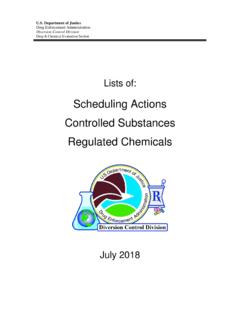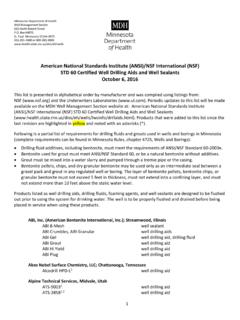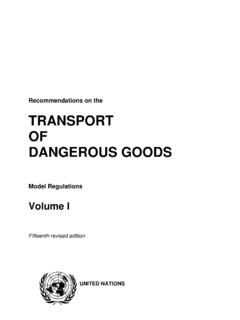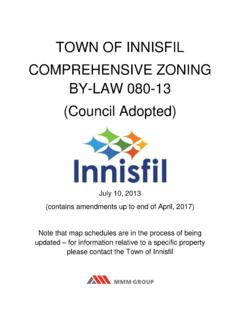Transcription of Guidance on the Generation & Submission of …
1 Guidance ON THE Generation AND. Submission OF CHEMISTRY DATA IN SUPPORT. OF THE approval OF NON- agricultural . pesticides . Page 1. CONTENTS. 1. INTRODUCTION. Background Page 3. New Guidance Document Page 3. Guidance on data waiver and the preparation of reasoned cases Page 3. 2. AMPLIFICATION OF THE DATA REQUIREMENTS. Overview Page 5. Identity of the active ingredient Page 6. Physico-chemical properties of the active ingredient Page 8. Information on the formulation Page 14. Analysis Page 20. 3. Guidance ON REPORTING STANDARDS FOR DATA Submission AND. REPORT FORMAT. General points Page 23. Good Laboratory Practice (GLP) Page 23. Reporting Format Page 24. APPENDIX 1. Summary of the Chemistry Data requirements for Non- agricultural pesticides Page 26. GLOSSARY OF TERMS Page 28. REFERENCES Page 30. Page 2.
2 1. INTRODUCTION. Non- agricultural pesticides are presently regulated in Great Britain under The Control of pesticides Regulations (COPR) 1986, as amended, and require approval before they can be sold, supplied, stored, used or advertised. The term non- agricultural pesticide covers wood preservatives, wood treatment products, biocidal paints, surface biocides, rodenticides and insecticides/acaricides for use in public hygiene situations, avicides, bird stupefying baits and antifouling products. This Guidance document is one of a series of documents that has been developed by HSE's Biocides and pesticides Assessment Unit (BPAU) to support the approval of non- agricultural pesticides under COPR. Background Following agreement of the Advisory Committee of pesticides , the BPAU produced a Guidance document Data requirements for non- agricultural pesticides products and their active substances (found in Part Three/A of the Registration Handbook).
3 The requirements published in July 1993 establish a consolidated (core) set of data requirements for all non- agricultural pesticides . The core data requirements apply to the registration of a non- agricultural pesticide containing a new active ingredient and also to support the review of older active ingredients and their products. New Guidance document The chemistry data requirements outlined within the consolidated core data requirements are summarised in Appendix 1 of this document. This additional Guidance is intended to supplement the information found within BPAU's Consolidated core data requirements and also aims to promote consistency, transparency and high scientific standards in the Generation and reporting of these data. This document provides: Background on why these data are needed and how they are used Guidance on data waiver and reasoned cases Amplification of the individual test requirements for physical and chemical data Guidance on reporting standards Guidance on data waiver and the preparation of reasoned cases The consolidated data requirements are regarded as a minimum set for all non- agricultural pesticidal active ingredients and products.
4 However there will be occasions where data requirements can be waived. Valid reasons for not submitting a complete core data set fall into the following categories: (i) The study is not technically possible to perform Page 3. In some cases the intrinsic physico-chemical properties of the substance or product are such that not all the core data set tests can be performed ( on very volatile or unstable substances). Information on technical limitations detailed in test guidelines for a specific method should always be respected. (ii) Other existing data can be used instead of required data Information on an active substance or product may be derived in certain circumstances from other sources. For example, with certain isomers or structurally similar compounds, it may be possible to read-across from existing data.
5 (iii) The study is not scientifically necessary In some cases it is not scientifically justified to perform a study due to the intrinsic properties of the active substance or product. In some cases the characteristics of the active substance or product are such that a study is simply not relevant, for -1. example if the water solubility is less than 1 mg l then the surface tension study need not be performed. Other reasons may also be valid and it is up to the applicant to decide the basis for the preparation of a reasoned case against providing the data In those instances when an applicant is considering providing a reasoned case for extrapolation (see (ii) above) or non- Submission of data, it is highly recommended that they contact the BPAU to discuss the situation before beginning any work. It is stressed that the onus is on the applicant to make the case for not generating new data.
6 Applicants should base their case on scientific arguments or other information which demonstrates that the Generation of new data is unnecessary. It is understood that applicants may wish to comment briefly on the commercial implications, but such concerns should not form the main basis of the case. Arguments should be supported by reference to appropriate data and a full list of the references cited should be provided to BPAU. Any literature cited to support a reasoned case should be summarised in sufficient detail to determine the validity of the arguments presented. If an applicant refers to any literature owned by another company and these data are not in the public domain, they will be required to demonstrate that they are entitled to make use of the data, for example, by Submission of a letter of access.
7 A reasoned case should not just present a description of data but should also explain how these data relate to the data requirements. Applicants will be required to interpret their data and make their own case. 2. AMPLIFICATION OF THE DATA REQUIREMENTS. The list of consolidated (chemistry) data requirements is presented in Appendix 1. This section presents an overview of these requirements and provides amplification of the individual requirements including information on test guidelines and methodologies that are available to applicants. Page 4. Overview Data submitted to meet the physico-chemical data requirements fall into two main categories: Information on identity, composition, analysis and information on specific physical and chemical characteristics of pesticidal active ingredients and products.
8 Identity, Composition and analysis Composition data are used in several ways. BPAU will examine the composition of a technical active ingredient or formulated product to determine whether the active ingredient or product contains any ingredient in an amount that may cause unreasonable adverse effects on human health or the environment. Physical and Chemical characteristics Data on the physical and chemical characteristics of pesticidal active ingredients and products are required. Some characteristics confirm or provide supportive information on the identity of ingredients and products. This is particularly true for such properties as colour, odour, physical state, melting and boiling points, density, solubility, vapour pressure and pH. Such information as colour, odour, physical state, pH and viscosity is also needed to respond to emergency requests for identification of unlabelled pesticides involved in accidents or spills.
9 Medical Practitioners, hospitals and poison control centres will, on occasion, also request such information. Physical and chemical characteristics data are used directly in hazard assessment. These include pH, stability, oxidising and reducing action, flammability, explosive properties, corrosivity and storage stability. For example, BPAU require storage stability data on a pesticidal formulation as this provides data on change (or lack of change) in product composition over time, which gives an indication of the shelf life of the product; if certain active ingredients decompose, then potentially other new chemicals are formed whose toxicity and other properties may need to be considered. Determination of the UV/Visible absorption spectrum of a pesticide provides some indication of the wavelengths at which a compound may be susceptible to photodegradation.
10 Since photochemical degradation is likely to occur in both the atmosphere and aquatic environment, spectra appropriate to these media will provide information concerning the need for further persistence testing. Additionally, certain physico-chemical data are needed as basic or supportive evidence in initiating or evaluating studies in other areas, The octanol/water partition coefficient is used as a criterion in determining whether certain aquatic organism and wildlife toxicity studies are needed. Data on vapour pressure may be used in support decisions as to appropriate re-entry intervals for some pesticidal products in situations where residues in air pose a potential hazard or there is a potential for inhalation exposure arising from handling the active ingredient . IDENTITY OF THE ACTIVE INGREDIENT.














